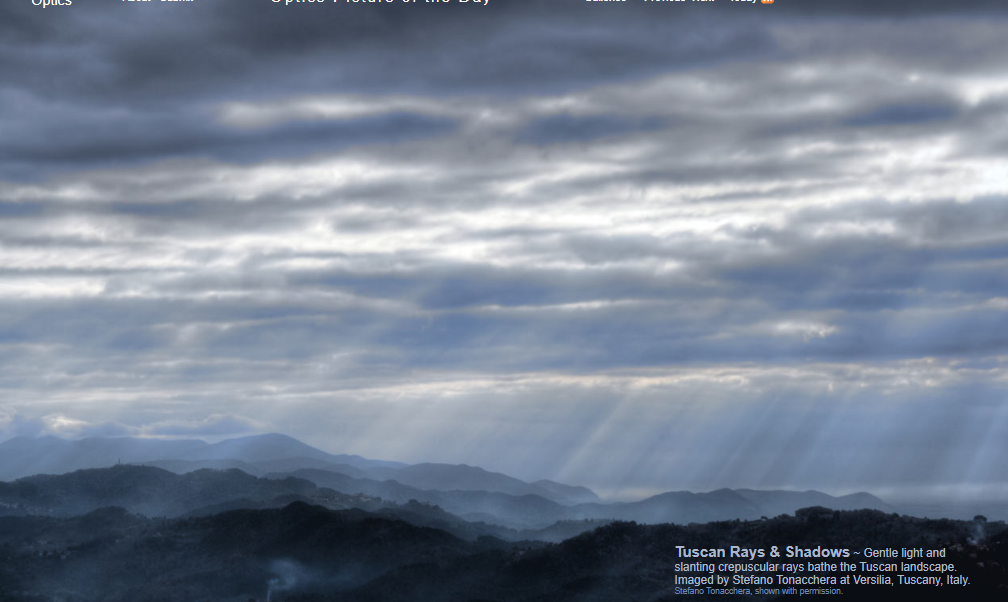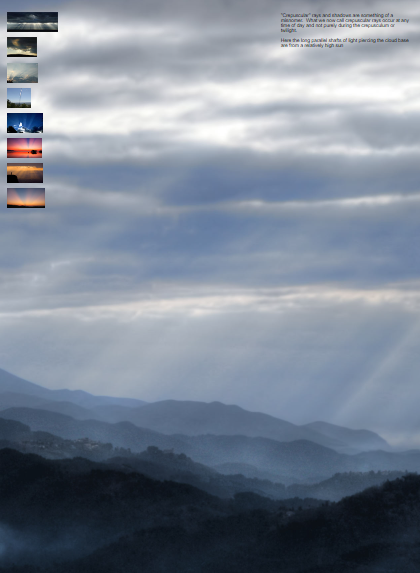OPOD - Tuscany Shadows
OPOD - Tuscany Shadows: A Closer Look at Crepuscular Rays
The enchanting Tuscan landscape is known for its picturesque beauty and ethereal atmosphere. One of the captivating phenomena that adorn the skies above Tuscany is the presence of crepuscular rays and shadows. These mesmerizing beams of light, captured by Stefano Tonacchera in Versilia, Italy, create a stunning interplay between gentle illumination and slanting shadows. While commonly referred to as "crepuscular" rays, it is important to note that these rays can appear at any time of day, not solely during twilight.
The phenomenon of crepuscular rays occurs when sunlight passes through gaps or breaks in clouds, creating long parallel shafts of light that seem to radiate from a single point in the sky. Although typically associated with the early morning or late afternoon hours, these rays can manifest when the sun is relatively high in the sky, as evidenced by Tonacchera's captivating photographs.
To fully appreciate the beauty of crepuscular rays and shadows in Tuscany, it is worth delving into the scientific explanation behind this atmospheric phenomenon. The primary factor contributing to the formation of these rays is the interaction between sunlight and the presence of clouds or other obstructions in the atmosphere. When sunlight encounters these obstacles, it scatters in various directions, with some of the rays finding their way through gaps in the clouds. As these rays pass through the atmosphere, they interact with particles such as dust or water droplets, which further scatter and diffuse the light. This scattering process gives rise to the distinct appearance of crepuscular rays.
The seemingly parallel nature of crepuscular rays is an optical illusion caused by perspective. In reality, the rays diverge from the point where sunlight passes through the clouds, creating an apparent convergence as they extend towards the observer on Earth. This convergence effect enhances the visual impact of the rays, making them appear more pronounced and dramatic.
While crepuscular rays are often associated with the interplay of light and shadow, it is important to note that shadows alone can also contribute to the overall aesthetic appeal of the scene. In Tonacchera's photographs, the slanting shadows cast by objects on the Tuscan landscape add depth and dimension to the composition. These shadows are a result of the obstructive nature of the objects, blocking some of the sunlight and creating areas of relative darkness. The contrast between the illuminated areas and the shadows further enhances the visual impact of the scene, creating a captivating interplay of light and dark.
In addition to their aesthetic allure, crepuscular rays and shadows serve as a reminder of the intricate workings of our atmosphere. The presence of these phenomena is a testament to the dynamic interplay between sunlight, atmospheric particles, and obstructions such as clouds or objects on Earth's surface. By observing and appreciating these atmospheric optics, we gain a deeper understanding of the complex interactions that shape our visual experience of the world around us.
In conclusion, Tuscany's enchanting landscapes are further adorned by the presence of crepuscular rays and shadows. These captivating phenomena, captured in Stefano Tonacchera's photographs, create a mesmerizing interplay of light and shadow that adds depth and dimension to the Tuscan scenery. While commonly associated with twilight, crepuscular rays can manifest at any time of day, with their parallel appearance being an optical illusion caused by perspective. By appreciating these atmospheric optics, we gain insight into the intricate workings of our atmosphere and the dynamic interactions that shape our visual perception.

Tuscan Rays & Shadows ~ Gentle light and slanting crepuscular rays bathe the Tuscan landscape. Imaged by Stefano Tonacchera at Versilia, Tuscany, Italy. Stefano Tonacchera, shown with permission.
"Crepuscular" rays and shadows are something of a misnomer. What we now call crepuscular rays occur at any time of day and not purely during the crepusculum or twilight.
Here the long parallel shafts of light piercing the cloud base are from a relatively high sun.

Note: this article has been automatically converted from the old site and may not appear as intended. You can find the original article here.
Reference Atmospheric Optics
If you use any of the definitions, information, or data presented on Atmospheric Optics, please copy the link or reference below to properly credit us as the reference source. Thank you!
-
<a href="https://atoptics.co.uk/blog/opod-tuscany-shadows/">OPOD - Tuscany Shadows</a>
-
"OPOD - Tuscany Shadows". Atmospheric Optics. Accessed on April 25, 2024. https://atoptics.co.uk/blog/opod-tuscany-shadows/.
-
"OPOD - Tuscany Shadows". Atmospheric Optics, https://atoptics.co.uk/blog/opod-tuscany-shadows/. Accessed 25 April, 2024
-
OPOD - Tuscany Shadows. Atmospheric Optics. Retrieved from https://atoptics.co.uk/blog/opod-tuscany-shadows/.